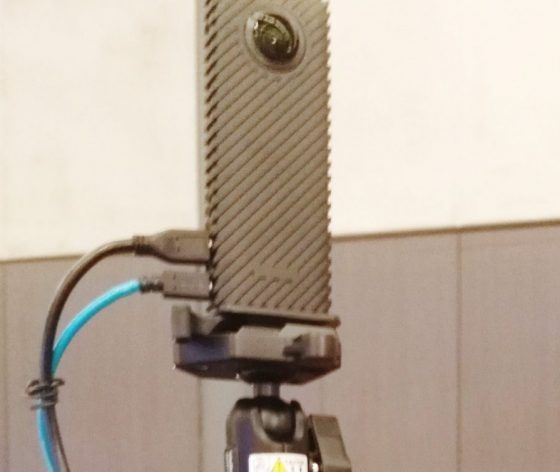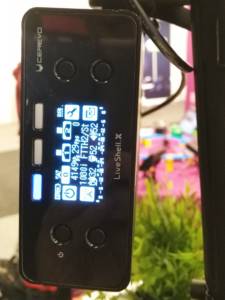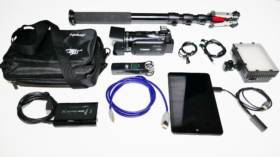At Mobile World Congress, during my last hours on the show floor I took some time to meet with Ricoh who have just launched the Ricoh R development kit for 360-degree live-streaming. I spent a good hour at the booth, mainly because of the mobile streaming rig they had put together.
I’ve tried mobile 360 degree livestreaming with the Ricoh ThetaS and it wasn’t very successful. Firstly the ThetaS needs a PC on which to run the image stitching software, virtual cam and streaming software. Secondly, like many cameras that aren’t built with video in mind, it overheats and shuts down. 20 minutes was about the best I got out of the system.The 360-degree interactive video I made is available.
The Ricoh R development kit is built to run for 24 hours with an external power supply (micro USB) and does the stitching in-cam. You get a much more useful spherical (equirectangular) full HD, 30 fps HDMI output that can be sent directly to YouTube (Note: Use only pre-prepared event streams marked as 360-degree videos.)
Ricoh had linked the HDMI to a LiveShell X mobile streaming box tethered to a phone sharing an LTE connection. With everything mounted on a monopod it was easy enough to just pick the unit up and walk around with it. So i did. For about 15 minutes around Hall 8. It was inspiring. I came away thinking about on-location live news reporting, tours and walk-and-talk promotional business videos. Unfortunately Ricoh have deleted the videos so I can’t show the original 360-degree stream. I made a video of the unit though…
12 hours later, back at home in Bonn, I found myself jumping out of bed and reaching for my 2-year old Lenovo Thinkpad 8 with the thought that this LTE, USB charge-and-data-capable tablet might have enough power to drive an even lighter solution. It does!
Rather than testing a 360-degree stream I attached an Elgato Game Capture unit via USB and connected a full HD video camera. With the Elgato software turned up to 5 mbps I successfully streamed a full HD live walkabout over the built-in LTE using a local (and loaned) (1und1.de) sim card. The whole system was powered using a USB power bank. 80% CPU utilisation isn’t ideal so I wouldn’t recommend anyone uses this setup for anything critical. Look for a Core m5 or better with LTE and a USB-C input and you’ll find it a lot more flexible. There are other limits to this setup too. But first, the video.
A 1920 x 960 360-degree video format isn’t great quality when you’re talking about viewing a small segment of a 360-degree video. 4K is entry-level and 60 fps is a must for smoothness. All that adds up to a bit-rate that goes beyond most consumer LTE packages. Even if you switch to an H.265 stream (with approx. half the bandwidth requirements) you’ll be up ii the 20 mbps – 50 mbps range. Oh, and good luck finding 360 degree video hardware that can do this for under $20K. I haven’t even mentioned HDR yet. It’s an important aspect of 360 degree videography. We really are at the start of the 360-degree video journey. But I think it’s going to be a fast-growing one.
Despite the limitations I’m excited about ultra-mobile 360. At the sub $2K level there are a large number of live and post-processed applications in many sectors. It’s hugely significant for web video platforms and quite possibly the best way to get traction on Facebook today. If you’re running a newsroom you’d be mad not pre-order the Ricoh R development kit for experimentation purposes. Yes, it’s going to be out of date in a year but this is the price of being at the leading edge.
I’m following the 360-degree video and photo sector very closely now. Expect more from me on this topic soon.














